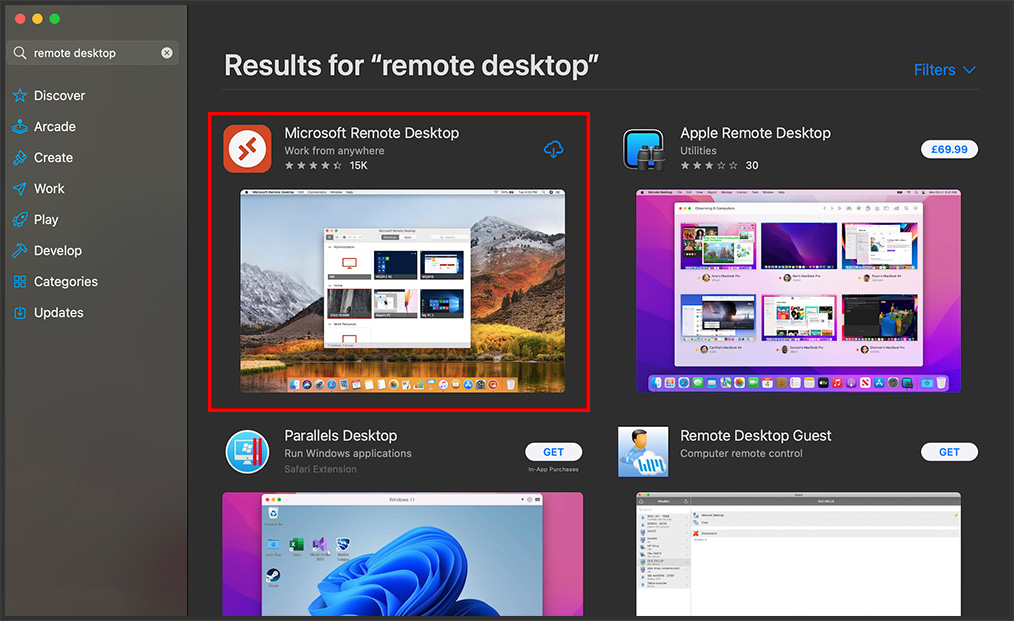

- MICROSOFT REMOTE DESKTOP CONNECTION MAC MOUNTAIN LION MAC OS X
- MICROSOFT REMOTE DESKTOP CONNECTION MAC MOUNTAIN LION INSTALL
- MICROSOFT REMOTE DESKTOP CONNECTION MAC MOUNTAIN LION PASSWORD
If you can’t remember what you named your computer, you can find that information on the “System” control panel. In the command prompt, type “ipconfig” and hit “Return.” You want to use the IPv4 address it gives you. Use the keyboard shortcut “Windows + R” and then type “cmd” to open a command prompt. If you want to know what your PC’s name and/or IP address is, you need to check.
MICROSOFT REMOTE DESKTOP CONNECTION MAC MOUNTAIN LION PASSWORD
Also, if you do not want to enter your user name and password every time you connect, you can add them to the “Credentials.” Not entering any credentials means that when you connect to your Windows machine, you will need to log into an account. We don’t worry about configuring a gateway because we’re connecting to our PC within our local network. Next to “Connection name” we give it a friendly name while the “PC name” is either the name we gave our target PC or its IP address. Let’s take a moment, however, to click “Edit” and show you what’s involved. In our example, we’ve already set up a user profile, which is ready for action. Remote Desktop will be installed in your Mac’s Application’s folder.
MICROSOFT REMOTE DESKTOP CONNECTION MAC MOUNTAIN LION INSTALL
You also want to make sure you install the Microsoft Remote Desktop client on your Mac. Open the System Properties and click the “Remote” tab, then make sure “Allow remote connections to this computer” is enabled. To connect to a Windows PC, you must first turn on remote connections. OS X and Windows have this ability built right into them, meaning you can easily share your Mac’s screen with Windows PCs, and vice versa.Ĭonnecting to Windows PC Clients from a Mac You paste your mac text into gedit, highlight it, copy it again then you are able to paste it in your Windows session.Sharing your screen remotely is a convenient way to access another computer as if you’re sitting in front of it. You can copy info from rdesktop to the mac but not back. The one big caveat with using rdesktop so far for me has been the clipboard. The nice part of using scripts is that you can launch a bunch of sessions quickly - faster than you can do in Windows RDC or Mac RDC! If you want to connect to the console of the Windows Server or XP box, use "-0" in the command. You can add "-p password" but since these are clear text shell scripts, you will create a security issue and Windows already is insecure enough without your Mac adding to the problem.

#!/bin/sh/usr/local/bin/rdesktop -u username -d domain -a 16 -g 1024x768 server.ip.address.or.fqdn &This little script will launch a RDC session at 1024x768 & 65k colors, put your login name and domain name in the MSGina winlogon. #!/bin/shcurl -O -zxvf rdesktop-1.4.0.tar.gzcd rdesktop-1.4.0./configuremakesudo make installOnce you have rdesktop installed, then you can start writing little shell scripts to launch you RDC sessions from xterm or iTerm (my fav) after launching X11. Here is an example script that will do all the dirty work for you. All you need to do is make sure you have X11 and the X11 SDK installed.

Instead of using Microsoft RDC for Mac, I compiled rdesktop and launch sessions with shell scripts.
MICROSOFT REMOTE DESKTOP CONNECTION MAC MOUNTAIN LION MAC OS X
I manage 80 or so Windows 2000 & Windows 2003 Servers with my Mac OS X box (much to my CIO's annoyance).


 0 kommentar(er)
0 kommentar(er)
